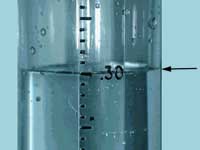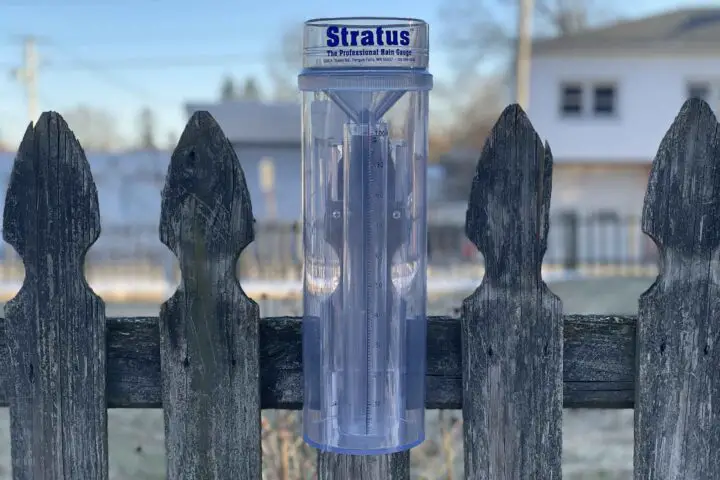- A time-tested design
- Difficult to handle when measuring precipitation from the outer gauge
Date of our Original Review: 2019
We usually only cover digital weather stations here on The Weather Station Experts. Still, we think even current weather station owners should pick the Stratus Precision Rain Gauge. It’s quickly become a favorite here, and it’s all about the Stratus rain gauge’s precision and accuracy. But why would you want an analog rain gauge if your digital weather station can measure rain?
A precision analog rain gauge is the best way to ensure accuracy (and confirm your personal weather station’s measurements) and a must for official weather observers and enthusiasts alike. Personal weather stations, especially the Davis Vantage Vue and Vantage Pro2, measure rainfall well. However, even the highest quality weather stations have a margin of error, which increases in heavy rain.
Digital rain gauges can’t compete
The Stratus Rain Gauge is the best rain gauge on the market and is a bestseller despite being many times more expensive than your typical store-bought rain gauge. Stratus based the design on a National Weather Service standard, and it holds up to 11 inches of rain thanks to its dual cylinder measuring tube design. It will accurately monitor rainfall down to 0.01″ increments.
The extra-large outer cylinder holds another 10 inches of precipitation when the inner tube is full. The inner cylinder and funnel top are also removable, allowing you to catch snowfall, which you can melt down to determine a liquid equivalent. Included with the package are a mounting bracket and mounting screw. We attached our rain gauge to a fence post.
We have a Stratus installed here at our testing site to help us gauge the accuracy of the digital rain gauges we test, and it hasn’t failed us. It’s made of heavy-duty UV-resistant polycarbonate (a durable clear plastic), making it frost and weather-resistant. We’ve only had our Stratus Precision Rain Gauge for years, and we can report years of trouble-free use.
If you plan to participate in rainfall data reporting networks like CoCoRAHS, you must purchase a gauge like the Stratus or another rain gauge designed to National Weather Service specifications (there aren’t many). These programs typically will not accept rainfall reports from personal weather stations. But even if you’re not, we still think many weather station owners will find the Stratus useful.
Digital gauges are very popular; however, you’ll never get the precise measurements you will with an analog rain gauge, especially the Stratus Precision Rain Gauge. Made of UV-resistant polycarbonate plastic, the Stratus can measure up to 11″ of rain (1″ in the inner tube and up to 10″ in the outer cylinder.
You’ll get precise rainfall readings to .01″, and the Stratus is built to National Weather Service standards. The Stratus is the preferred rain gauge if you’re planning to join a rainfall reporting network like CoCoRAHS.
The Stratus comes with a mounting bracket that you can place on a post and easily slide the Stratus on and off the bracket to measure rainfall and clean the gauge. While it’s as expensive as some digital rain gauges, you’ll be able to measure both rain and snow, something digital gauges cannot do.
Which rain gauge is most accurate?
An analog rain gauge will always be the better option over a digital or WiFi rain gauge. While digital rain gauges certainly have gotten much better over time, the still aren’t as accurate as the traditional rain gauge. This is why the NWS requires its observers report rainfall from an analog rain gauge.
How do you read a Stratus Precision Rain Gauge?
That said, once you purchase your rain gauge, we recommend watching CoCoRAHS’ educational videos to learn how to use it properly. We’ve included the entire set of training videos below for your convenience.
[embedyt] https://www.youtube.com/embed?listType=playlist&list=PL86DC4C330F518387&layout=gallery[/embedyt]While you don’t have to watch all of them unless you plan to participate in CoCoRAHS, these videos will teach you the basics of correctly measuring rainfall (and snowfall). We recommend following their suggestions as close as possible for the most accurate measurements.
Reading the rain gauge is simple. As rain falls, it will accumulate within the smaller cylinder. You’ll need to have the gauge at eye level to read the gauge. The measurement is where the lowest point of the water inside the cylinder falls, called the meniscus.

The meniscus develops due to the surface tension of the water in contact with the inner tube’s sides. The picture above illustrates this. The bottom of the meniscus is closest to .30″, which would be the measurement.
If you’ve received more than 1″ of rain, you’ll need to measure the rain in the inner cylinder first, then empty it and carefully fill it with the remaining water from the outer cylinder. Repeat this process until all the water in the outer cylinder is gone, then add up all your measurements for the total.
Can I measure snowfall with my Stratus Rain Gauge?
You’ll need to remove both the inner cylinder and the funnel for measuring snowfall. Allow the snow to accumulate inside the outer cylinder. When you’re ready to take a measurement, bring the rain gauge inside, and fill the inner cylinder with warm water.
Be sure first to measure how much water you’re adding. Pour the inner cylinder water into the outer cylinder filled with snow, then let it melt (carefully sloshing around the contents helps speed the process). Once fully melted, use the method above to obtain your measurement, subtracting the warm water measurement from your total.
The resulting number is the “water equivalent” of your snowfall measurement. Some people prefer to use the “core sample” method for better accuracy, as discussed in the CoCoRAHS videos we linked above.






